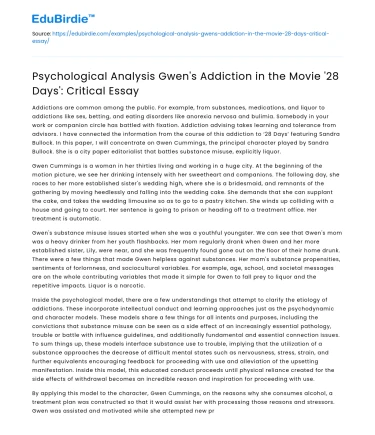Addictions are common among the public. For example, from substances, medications, and liquor to addictions like sex, betting, and eating disorders like anorexia nervosa and bulimia. Somebody in your work or companion circle has battled with fixation. Addiction advising takes learning and tolerance from advisors. I have connected the information from the course of this addiction to ‘28 Days’ featuring Sandra Bullock. In this paper, I will concentrate on Gwen Cummings, the principal character played by Sandra Bullock. She is a city paper editorialist that battles substance misuse, explicitly liquor.
Gwen Cummings is a woman in her thirties living and working in a huge city. At the beginning of the motion picture, we see her drinking intensely with her sweetheart and companions. The following day, she races to her more established sister's wedding high, where she is a bridesmaid, and remnants of the gathering by moving heedlessly and falling into the wedding cake. She demands that she can supplant the cake, and takes the wedding limousine so as to go to a pastry kitchen. She winds up colliding with a house and going to court. Her sentence is going to prison or heading off to a treatment office. Her treatment is automatic.
Save your time!
We can take care of your essay
- Proper editing and formatting
- Free revision, title page, and bibliography
- Flexible prices and money-back guarantee
Gwen's substance misuse issues started when she was a youthful youngster. We can see that Gwen's mom was a heavy drinker from her youth flashbacks. Her mom regularly drank when Gwen and her more established sister, Lily, were near, and she was frequently found gone out on the floor of their home drunk. There were a few things that made Gwen helpless against substances. Her mom's substance propensities, sentiments of forlornness, and sociocultural variables. For example, age, school, and societal messages are on the whole contributing variables that made it simple for Gwen to fall prey to liquor and the repetitive impacts. Liquor is a narcotic.
Inside the psychological model, there are a few understandings that attempt to clarify the etiology of addictions. These incorporate intellectual conduct and learning approaches just as the psychodynamic and character models. These models share a few things for all intents and purposes, including the convictions that substance misuse can be seen as a side effect of an increasingly essential pathology, trouble or battle with influence guidelines, and additionally fundamental and essential connection issues. To sum things up, these models interface substance use to trouble, implying that the utilization of a substance approaches the decrease of difficult mental states such as nervousness, stress, strain, and further equivalents encouraging feedback for proceeding with use and alleviation of the upsetting manifestation. Inside this model, this educated conduct proceeds until physical reliance created for the side effects of withdrawal becomes an incredible reason and inspiration for proceeding with use.
By applying this model to the character, Gwen Cummings, on the reasons why she consumes alcohol, a treatment plan was constructed so that it would assist her with processing those reasons and stressors. Gwen was assisted and motivated while she attempted new practices and ways of dealing with stress to use when experiencing her stressors. By tending to Gwen's hidden causes of her fixation, it was done to diminish the probability of relapsing. This is one of the benefits of the psychological model of addiction. Gwen Cummings would grasp a desire for recuperation by using this method to deal with the location of her mental pressure and adapting new adapting aptitudes to counter her dependence.
As indicated by the DSM-V, Gwen meets the criteria for the liquor use issue. She meets four out of the eleven criteria. As stated in the DSM-V, she constantly wants to utilize liquor. Going out to drink with her beau and companions is a normal social movement that she appreciates, and she wouldn't like to stop. Drinking has prompted her powerlessness to satisfy her work commitments. She keeps on drinking despite the way that it meddles with her relational connections, explicitly with her sister. Whenever Gwen and Lily communicate, there is a constant strain. Lily needs to incorporate Gwen in significant life occasions, for example, her wedding, yet, in addition, feels baffled by her when Gwen appears alcoholic. Gwen likewise gets drunk and drives, as found in the motion picture where she drives the wedding limousine. There isn't sufficient data from the motion picture to propose that she meets more criteria. I would characterize Gwen's seriousness as moderate since four manifestations are available.
The behavioral formation would be successful in Gwen's treatment. The conduct involves positive reinforcement, negative reinforcement, and discipline. Gwen has gotten uplifting feedback for drinking, for example, wonderful emotions, kinships, and a relationship. It is hard to implement negative support since Gwen is a grown-up, yet one can see that discipline is working. Because of her drinking and driving episode, she has compulsory addiction treatment. A token economy could be compelling, so Gwen would see the positives of drinking less. One would foresee more clear basic leadership, effectively taking an interest in the working environment, and participating in exercises and diversions that bring delight.
What I understand from the movie ‘28 Days’ is that individuals with psychological disorders are additionally trashed by the general population around them, bringing about disgrace and humiliation, just as preference and victimization. In this way, the comprehension and treatment of psychological disorders have wide ramifications for the regular daily existence of numerous individuals. Psychological disorders share much for all intents and purposes with other restorative issues. They are out of the patient's control, they may now and again be treated by medications, and their treatment is frequently secured by restorative protection. Psychological disorders have both biological as well as environmental influences.






 Stuck on your essay?
Stuck on your essay?

